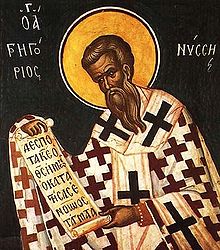
Back غريغوريوس أسقف نيصص Arabic غريغوريوس النيسى ARZ Gregoriu de Nisa AST Nissalı Qriqori Azerbaijani Григорий Нисийски Bulgarian Gregori de Nissa Catalan Řehoř z Nyssy Czech Gregor fra Nyssa Danish Gregor von Nyssa German Γρηγόριος Νύσσης Greek
Gregory of Nyssa | |
|---|---|
 | |
| Cappadocian Father | |
| Born | c. 335 Neocaesarea, Cappadocia, Roman Empire (modern-day Niksar, Tokat, Turkey) |
| Died | c. 394 Nyssa, Cappadocia, Roman Empire (modern-day Harmandalı, Ortaköy, Aksaray, Turkey) |
| Venerated in | Eastern Orthodox Church Catholic Church Oriental Orthodoxy Anglicanism Lutheranism |
| Feast | 10 January (Eastern Christianity, Catholic Church since 2001, Lutheran Church–Missouri Synod[1])) 26 Hathor (Coptic Christianity)[2] 9 March (Catholic Church before 2001 and the Episcopal Church USA)[3] 14 June, with Macrina (ELCA) 19 July, with Macrina (Anglican Communion) |
| Part of a series on |
| Catholic philosophy |
|---|
   |
| Part of a series on the |
| Eastern Orthodox Church |
|---|
| Overview |
Gregory of Nyssa, also known as Gregory Nyssen (Ancient Greek: Γρηγόριος Νύσσης or Γρηγόριος Νυσσηνός; c. 335 – c. 394), was an early Roman Christian prelate who served as Bishop of Nyssa from 372 to 376 and from 378 until his death in 394. He is venerated as a saint in Eastern Orthodoxy, Catholicism, Oriental Orthodoxy, Anglicanism, and Lutheranism. Gregory, his elder brother Basil of Caesarea, and their friend Gregory of Nazianzus are collectively known as the Cappadocian Fathers.
Gregory lacked the administrative ability of his brother Basil or the contemporary influence of Gregory of Nazianzus, but he was an erudite Christian theologian who made significant contributions to the doctrine of the Trinity and the Nicene Creed. Gregory's philosophical writings were influenced by Origen. Since the mid-twentieth century, there has been a significant increase in interest in Gregory's works from the academic community, particularly involving universal salvation, which has resulted in challenges to many traditional interpretations of his theology.
- ^ Lutheranism 101, CPH, St. Louis, 2010, p. 277
- ^ "Hator 26 : Lives of Saints : Synaxarium - CopticChurch.net".
- ^ Lesser Feasts and Fasts 2018. Church Publishing, Inc. 2019-12-01. ISBN 978-1-64065-234-7.